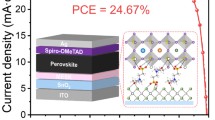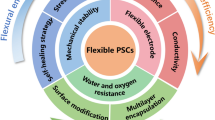Abstract
For low-cost and lightweight polymer/plastic substrates in flexible building-integrated photovoltaic (BIPV) modules, low-temperature processing is essential. Amorphous silicon (a-Si:H) requires processing at a temperature of 200–250 °C by plasma-enhanced chemical vapor deposition to obtain satisfactory optoelectronic properties, which limits such substrates in terms of thermal budget. This study is focused on the fabrication of p–i–n-type a-Si:H solar cells at relatively low temperatures (100 °C). Intrinsic a-Si:H films with large optical gaps (1.83 eV) were prepared at 100 °C using a high hydrogen dilution ratio. In addition, p-type amorphous silicon oxide and n-type microcrystalline silicon oxide films with large optical gaps and suitable conductivities were prepared at 100 °C using a gas mixture containing the dopant B2H6 or PH3 and CO2. Finally, an a-Si:H p–i–n cell was fabricated at 100 °C; it exhibited an excellent power conversion efficiency of 9.0%, which was higher than those reported for a-Si:H thin film photovoltaics prepared at 100 °C. We believe that this study will open promising routes for the development of high-performance and flexible BIPVs.
Graphic Abstract






Similar content being viewed by others
References
Peter, S.C.: Reduction of CO2 to chemicals and fuels: a solution to global warming and energy crisis. ACS Energy Lett. 3, 1557 (2018)
Attoye, D., Tabet Aoul, K., Hassan, A.: A review on building integrated photovoltaic façade customization potentials. Sustainability 9, 2287 (2017)
dos Santos, Í.P., Rüther, R.: The potential of building-integrated (BIPV) and building-applied photovoltaics (BAPV) in single-family, urban residences at low latitudes in Brazil. Energy Build. 50, 290 (2012)
Pagliaro, M., Ciriminna, R., Palmisano, G.: BIPV: merging the photovoltaic with the construction industry. Prog. Photovol. Res. Appl. 18, 61 (2010)
Chae, Y.T., Kim, J., Park, H., Shin, B.: Building energy performance evaluation of building integrated photovoltaic (BIPV) window with semi-transparent solar cells. Appl. Energy 129, 217 (2014)
Shukla, A.K., Sudhakar, K., Baredar, P.: Recent advancement in BIPV product technologies: a review. Energy Build. 140, 188 (2017)
Yang, J., Jo, H., Choi, S.-W., Kang, D.-W., Kwon, J.-D.: All pin hydrogenated amorphous silicon oxide thin film solar cells for semi-transparent solar cells. Thin Solid Films 662, 97 (2018)
Jo, H., Yang, J.-H., Lee, J.-H., Lim, J.-W., Lee, J., Shin, M., Ahn, J.-H., Kwon, J.-D.: Transparent bifacial a-Si: H solar cells employing silver oxide embedded transparent rear electrodes for improved transparency. Sol. Energy 170, 940 (2018)
Wook Lim, J., Shin, M., Lee, D.J., Hyun Lee, S., Jin Yun, S.: Highly transparent amorphous silicon solar cells fabricated using thin absorber and high-bandgap-energy n/i-interface layers. Sol. Energy Mater. Sol. Cells 128, 301 (2014)
Virtuani, A., Strepparava, D.: Modelling the performance of amorphous and crystalline silicon in different typologies of building-integrated photovoltaic (BIPV) conditions. Sol. Energy 146, 113 (2017)
Myong, S.Y., Jeon, S.W.: Efficient outdoor performance of esthetic bifacial a-Si: H semi-transparent PV modules. Appl. Energy 164, 312 (2016)
Jung, K.H., Yun, S.J., Lee, S.H., Lee, Y.J., Lee, K.-S., Lim, J.W., Kim, K.-B., Kim, M., Schropp, R.E.I.: Double-layered Ag–Al back reflector on stainless steel substrate for a-Si: H thin film solar cells. Sol. Energy Mater. Sol. Cells 145, 368 (2016)
Korevaar, B.A., Adriaenssens, G.J., Smets, A.H.M., Kessels, W.M.M., Song, H.Z., van de Sanden, M.C.M., Schram, D.C.: High hole drift mobility in a-Si: H deposited at high growth rates for solar cell application. J. Non-Cryst. Solids 266–269, 380 (2000)
Jeon, M., Yoshiba, S., Kamisako, K.: Hydrogenated amorphous silicon film as intrinsic passivation layer deposited at various temperatures using RF remote-PECVD technique. Curr. Appl. Phys. 10, S237 (2010)
Vygranenko, Y., Khosropour, A., Yang, R., Sazonov, A., Kosarev, A., Abramov, A., Terukov, E.: Lightweight amorphous silicon photovoltaic modules on flexible plastic substrate. Can. J. Phys. 92, 871 (2014)
Yang, R., Lee, C.-H., Cui, B., Sazonov, A.: Flexible semi-transparent a-Si: H pin solar cells for functional energy-harvesting applications. Mater. Sci. Eng. B 229, 1 (2018)
Tao, K., Wang, J., Cai, H., Zhang, D., Sui, Y., Zhang, Y., Sun, Y.: Low-temperature preparation of flexible a-Si: H solar cells with hydrogenated nanocrystalline silicon p layer. Vacuum 86, 1477 (2012)
Brinza, M., Rath, J.K., Schropp, R.E.I.: Thin film silicon n–i–p solar cells deposited by VHF PECVD at 100 °C substrate temperature. Sol. Energy Mater. Sol. Cells 93, 680 (2009)
Koch, C., Ito, M., Schubert, M.: Low-temperature deposition of amorphous silicon solar cells. Sol. Energy Mater. Sol. Cells 68, 227 (2001)
Alpuim, P., Chu, V., Conde, J.P.: Amorphous and microcrystalline silicon films grown at low temperatures by radio-frequency and hot-wire chemical vapor deposition. J. Appl. Phys. 86, 3812 (1999)
Guha, S., Yang, J., Williamson, D.L., Lubianiker, Y., Cohen, J.D., Mahan, A.H.: Structural, defect, and device behavior of hydrogenated amorphous Si near and above the onset of microcrystallinity. Appl. Phys. Lett. 74, 1860 (1999)
Mandal, S., Dhar, S., Das, G., Mukhopadhyay, S., Barua, A.K.: Development of optimized n-μc-Si:H/n-a-Si: H bilayer and its application for improving the performance of single junction a-Si solar cells. Sol. Energy 124, 278 (2016)
Kang, D.-W., Sichanugrist, P., Zhang, H., Konagai, M.: Wide-bandgap p-type microcrystalline silicon oxycarbide using additional trimethylboron for silicon heterojunction solar cells. Prog. Photovolt. Res. Appl. 25, 384 (2017)
Ambrosio, R., Moreno, M., Torres, A., Carrillo, A., Vivaldo, I., Cosme, I., Heredia, A.: Deposition and characterization of amorphous silicon with embedded nanocrystals and microcrystalline silicon for thin film solar cells. J. Alloys Compd. 643, S27 (2015)
Goyal, A., Soni, P.R.: Functionally graded nanocrystalline silicon powders by mechanical alloying. Mater. Lett. 214, 111 (2018)
Elarbi, N., Jemaï, R., Outzourhit, A., Khirouni, K.: Amorphous/microcrystalline transition of thick silicon film deposited by PECVD. Appl. Phys. A 122, 566 (2016)
Gabriel, O., Kirner, S., Klingsporn, M., Friedrich, F., Stannowski, B., Schlatmann, R.: On the plasma chemistry during plasma enhanced chemical vapor deposition of microcrystalline silicon oxides. Plasma Process. Polym. 12, 82 (2015)
Nakada, K., Miyajima, S., Konagai, M.: Application of n-type microcrystalline silicon oxide as back reflector of crystalline silicon heterojunction solar cells. Jpn. J. Appl. Phys. 54, 082301 (2015)
Das, G., Bose, S., Mukhopadhyay, S., Banerjee, C., Barua, A.K.: Innovative utilization of improved n-doped μc-SiOx: H films to amplify the performance of micromorph solar cells. Silicon 11, 487 (2019)
Acknowledgements
This research was supported by the National Research Foundation of Korea (NRF) Grant funded by the Korean Government (MSIT; NRF-2018R1C1B6008028) and was also supported by the Chung-Ang University Research Scholarship Grants in 2019.
Author information
Authors and Affiliations
Corresponding author
Ethics declarations
Conflict of interest
There are no conflicts of interest to declare.
Additional information
Publisher's Note
Springer Nature remains neutral with regard to jurisdictional claims in published maps and institutional affiliations.
Rights and permissions
About this article
Cite this article
Kang, DW., Ryu, J. & Konagai, M. High-Performance Amorphous Silicon Thin Film Solar Cells Prepared at 100 °C: Toward Flexible Building-Integrated Photovoltaics. Electron. Mater. Lett. 15, 623–629 (2019). https://doi.org/10.1007/s13391-019-00161-8
Received:
Accepted:
Published:
Issue Date:
DOI: https://doi.org/10.1007/s13391-019-00161-8




